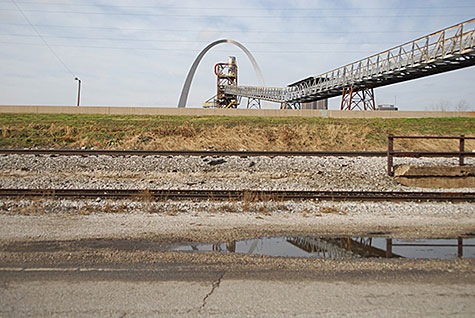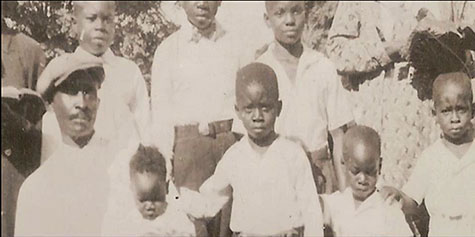
The Mississippi is wide but once it was wider, an artery of ice age melt. As glaciers retreated, the channel partly filled with soil, creating a sprawling, fertile floodplain known as the American Bottom.
Today, the American Bottom is defined less by geographic coherence than by fractures of history and population. Stretching from Alton, Ill., to Ste. Genevieve, Mo., the area encompasses rich farmland and entrenched urban poverty; delicate ecology and decaying infrastructure; anthropological treasure and industrial blight.
“Few regions in the United States exhibit a social and spatial fragmentation as extreme as that of the vast floodplains of the East St. Louis region,” said Jesse Vogler, visiting assistant professor of landscape architecture in the Sam Fox School of Design & Visual Arts at Washington University in St. Louis.
“It is a territory where UNESCO heritage sites abut Superfund sites, and where the first African-American incorporated town in the U.S. abuts the site of the country’s most notorious race riot,” said Vogler.
“Through this rather compact region, an entire history of North American settlement and aspirations can be told.”

The Divided City
This spring, Vogler and four colleagues are launching “Charting the American Bottom: St. Louis and Its Divided Periphery.” Conceived with Matthew Fluharty, PhD, a postdoctoral research fellow in the American Culture Studies program in Arts & Sciences, the project is one of three to win grant funding under the auspices of The Divided City, a new urban humanities initiative at Washington University.
Established by the Center for the Humanities in Arts & Sciences and the Sam Fox School’s College of Architecture and Graduate School of Architecture & Urban Design, The Divided City examines both the historical forms of urban separation and its present-day reality in cities around the world. It is funded in part by a four-year grant from the Andrew W. Mellon Foundation. In each of those years, organizers will host a Faculty Collaborative Grants competition, with selected projects receiving awards of up to $20,000 each.
In addition to Vogler and Fluharty, “Charting the American Bottom” is led by Angela Miller, PhD, professor of Art History & Archaeology in Arts & Sciences; Michael Allen, University College coordinator for American Culture Studies and director of the Preservation Research Office; and Andrew Theising, PhD, associate professor of political science at Southern Illinois University in Edwardsville.
Denise Ward-Brown, associate professor of art, and Helen Headrick, associate producer for the Higher Education Channel, will receive funding for “Tale of Two Cities: Documenting Our Divides.” The class — which will be offered next fall and is open to all Washington University students — responds to recent events in Ferguson, Mo., by bringing together teams of students to create films and videos documenting local grassroots reform efforts.
“The intersection of education, social justice, art and technology can bring into focus a powerful dialogue about social and spatial segregation,” Ward-Brown said. “When artists, designers, architects, planners and communicators engage in this critique, they help reframe the debate and shift momentum toward positive change.”
Catalina Freixas, assistant professor of architecture, and Mark Abbott, PhD, professor of history and director of the Center for Neighborhood Development at Harris-Stowe State University, will lead “Segregation by Design: A Historical Analysis of the Impact of Planning and Policy in St. Louis,” an interdisciplinary seminar that examines the role of planning and design in fostering segregation.
“Segregation as a consequence of design has been debated by scholars in fields as varied as architecture and urban studies and environmental policy and planning,” Freixas said. “However, this debate has rarely been placed in a historical context where policy leading to segregation is analyzed and seen as a product of the imbalance between social, economic and environmental factors in urban policy over time.”
“The intent is to develop a comprehensive approach to the study of segregation through debates on planning, policy and sustainability to address segregation in the coming years.”
The Center for the Humanities is accepting submissions for the second round of faculty grants and is especially interested in projects with an international focus. Proposals are due Monday, March 16.
For information, visit the Divided City website or email cenhum@artsci.wustl.edu.
